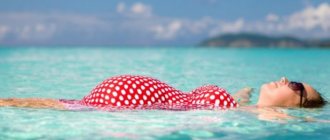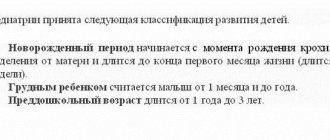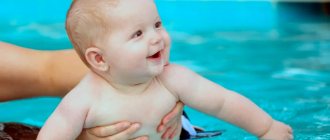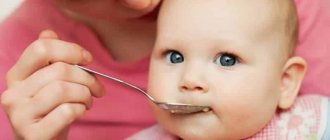Story
What infant swimming is for was studied in detail by Charkovsky. The rescue instructor managed to achieve impressive results. Charkovsky’s premature daughter was already ahead of her peers in terms of physical and intellectual development at three months old. A few months later the child began swimming in an adult pool. The girl independently dived to a depth of several meters.
Note! After achieving success in improving the health of his own daughter, Igor Charkovsky began to be invited to Children's Homes and parental homes. The rescue instructor's technique was contrary to the basic medical doctrines of the time. Therefore, infant swimming was not destined to become widespread.
In other countries, the development of the methodology was more progressive. In foreign countries, special research institutes appeared, whose employees were engaged in activities with children in the aquatic environment. The pioneers in this regard were the Austrian Timmermans family. Subsequently, the technique of infant swimming began to spread throughout Japan, Europe, and America.
The USSR Ministry of Health approved such classes for children of the first year of life only in the 70s of the last century. This was greatly facilitated by the activities of the Chairman of the Swimming Federation, Firsov. Soon, infant swimming departments were opened in all medical institutions for children, where special health courses were held.
Splash Swimming School
Splash Swimming School provides swimming lessons for children from 3 years of age and for adults of any age. Experienced instructors conduct group and personal lessons, guaranteeing a special approach to each student, taking into account his physical and physiological characteristics.
The cost of an individual lesson in swimming lessons from 3 years of age is 1,300 rubles. A subscription for 8 group classes will cost 5,200 rubles.
Branches of the swimming school for children from 3 years old are located near the Botanical Garden metro station at the address: st. Wilhelm Pika, 4/12, near the VDNH metro station at the address: st. Kasatkina, 23 and a small swimming pool - next to the Otradnoe metro station on Kargopolskaya street 15, building 1.
Physiological reflexes of a newborn
After birth and until the age of three months, a baby retains its innate instinctive skills, which are caused by a long stay in the mother’s belly. The main one of these reflexes, which helps the baby stay on the water, is swimming.
Note! Infants also have a developed respiratory reflex, which helps them hold their breath when diving under water. He is the one who helps teach diving to children in their first year of life.
Babies also have a developed push reflex. When the legs are forced to flex, the baby immediately straightens the lower limbs. Thanks to the push reflex, the baby eventually begins to push off from the sides and bottom of the pool.
The specific weight of an infant is much less than the weight of an adult. This has a positive effect on the child’s ability to float on the surface of the water with ease.
Mom is the best teacher
All authors of early swimming methods agree on one thing: there is no better teacher than mother. The key to success is mother's confidence. If you decide to teach your child to dive, you need to start after birth: after all, by three months the breath-holding reflex completely disappears. Ideally, the first time the baby is taught by an instructor who shows the parents what and how to do. From the age of one and a half months, you can go to a special children's pool, where the “infant group” is engaged. Such pools have now appeared in kindergartens and clinics in Moscow. There you can do a lot of useful exercises, for which the bath is too small, and for older children the pool is a great opportunity to swim to their heart's content.
What does infant swimming give?
Water training has a positive effect on:
- cardiovascular system. Active movements of the child in the water help strengthen the heart muscle, saturate the blood with oxygen, and activate blood flow;
- central nervous system. Infant swimming activates blood circulation in the brain, eliminates nervousness and irritability;
- respiratory system. Thanks to infant swimming, the drainage function of the lungs improves. Physical activity prevents the development of infectious diseases and has a general strengthening effect;
- musculoskeletal system. When the baby is in the water, the load on the joint, muscle and bone structures is evenly distributed. This contributes to the proper development of the baby’s muscle corset and spine. In the process of swimming, water resistance is overcome and the respiratory system is strengthened. As a result, the baby begins to crawl, walk and sit earlier than his peers;
- urinary system. The muscle activity observed during swimming improves kidney function. As a result, the removal of toxins from the baby’s body is activated.
Kimberley (South Administrative District)
Address: m. Sevastopolskaya, st. Azovskaya, 24 Website: https://www.kimberly.ru Phone: Cost: to be confirmed by phone
invites infants to swim lessons. Interesting activities with your mother will leave unforgettable emotions. The swimming pool for infants is completely safe and quite spacious.
If we move away from physical development and evaluate infant swimming from a practical point of view, then such activities in the pool from an early age gently, without stress and cold water, strengthen the baby’s body. This means that parents no longer associate the start of attending a preschool institution with an endless stream of respiratory infections and sick leave.
All exercises are carried out in a fully prepared swimming pool with a geyser, fountain and slides. The microclimate is carefully monitored here - the temperature of the air and water is maintained at an optimal level.
You also don’t have to worry about the quality of water - they use absolutely safe cleaning and disinfecting compounds. All classes in the infant pool are conducted under the supervision of experienced instructors and coaches, taking into account the characteristics of each child.
Child's age for mining swimming
According to most pediatricians, exercises in water should be started after the umbilical wound has healed (to avoid infection entering the wound). In addition, the baby needs time to adapt to living conditions outside the womb. The optimal age to start training is two months.
It is advisable to start classes until the baby’s innate swimming instincts are preserved. Otherwise, the necessary skills will have to be instilled from scratch, overcoming the baby’s fear of water.
Swimming pool "Grudnichok" (Southern Administrative District)
Address: m. Buninskaya alley, st. Alexandra Monakhova, 109, bldg. 4 Website: https://grudnichok.com Phone: Cost: from 500 rub. for 1 lesson
The sooner you come to swim, the faster you will swim on your own. Babies who swim from birth can dive perfectly by one year, swim in the pool by two, and are completely independent in the water by age 4. You will be proud of what your swimmer can do!
WHY HERE:
- Permanent discounts on subscriptions
- Babies up to 6 months – 10%
- Two swimmers from the same family and children from large families – 10%
- Bring a friend - plus one lesson
- UP TO 4 YEARS OLD swimming pool for infants only
By the end of the lesson there is new water in the pool! Here they work in the SDMP system, which has no analogues in the world.
FIRST VISIT RULES:
- children under 3 years old - a certificate for the pool from a pediatrician, children 3-4 years old - plus an analysis for enterobiasis.
- Arrive early to calmly change your baby’s clothes and go to class in a good mood.
- Take a diaper/towel with you; swim panties/diaper; flip flops for adults.
- It is better to feed your baby at least 1.5 hours before class. But you shouldn’t go to class hungry either.
The center administration reserves the right to replace the instructor without notifying visitors in unusual situations.
You are welcome to use creams and ointments after class, but not before class.
Techniques and techniques
In the 80s of the last century, Guterman’s technique was popular. It is designed in 4 main stages:
- Preparatory. This stage includes gymnastics and massage. Preparations begin on the fifth day after the baby is born. This stage ends when the baby reaches three months of age.
- Swimming training. Over the course of three months, the baby develops swimming reflexes in response to the mother’s commands. The baby gradually masters the basic movements. The baby becomes weaned from adult support.
- Independent swimming. The baby begins to swim and dive without assistance at the age of 6-9 months.
- Consolidation of acquired skills. At the age of one, the child masters scuba diving skills.
Aquaclub NEMO (Southern Administrative District, Eastern Administrative District)
Address:
- m. Prazhskaya, st. Kirovogradskaya, 36
- m. Academicheskaya, st. Vinokurova, 24, bldg. 4
- m. Maryino, Myachkovsky Boulevard, 16, bldg. 1
Website: https://aqua-nemo.ru Phone: +7 (977) 680-02-62 Cost: from 980 rub. for 1 lesson
The Nemo children's aqua club provides individual swimming lessons for children from 1.5 months to 7 years. Classes are held in game dynamics, taking into account the child’s age, state of health, psychological characteristics and ability to float on water.
HERE WE HAVE PROVIDED:
- Kids toys;
- changing tables;
- parking places;
- vestibule for strollers;
- changing room with hairdryer;
- coffee breaks.
The programs are developed taking into account the age of the child from 1.5 months, his state of health, psychological characteristics and ability to float on water. Many years of research by international institutions, as well as experience in teaching these methods in Russia, have shown that “water children” are more successful in their physical, emotional and mental development.
Exercises for infant swimming
Swimming involves regular exercise of simple exercises that are absolutely safe for the child. Adults need to remain focused and calm when training in an aquatic environment. In this case, the baby also feels confident.
splashing
Splashing is done as follows:
- The baby is held under the chin on the stomach with one hand. The other is gently patted on the water.
- An adult performs various movements with his palm. It is slowly driven along the surface of the water.
- You need to show your baby how the water flows smoothly from your hand. Subsequently, the baby will splash in the water on his own, getting real pleasure from this activity.
Pushes and turns
The baby is brought closer to the walls of the bath. The baby should feel the support with his legs, push off from it and swim. At the same time, the adult supports the baby when turning over. The main goal is to show the child that there is a relationship between the force of repulsion and the distance that the baby can swim.
Swimming in a straight line
The baby is placed on the tummy. A bright toy is placed in front of him, arousing the active interest of the baby. The baby needs to try to get a colorful object. At the same time, the toy is moved away from the tiny swimmer each time. The speed of movement also changes. The intensity of adult support is gradually weakened. The baby must understand that he can float on the water on his own.
Watercolors (North Administrative Okrug, Southern Administrative Okrug, Eastern Administrative Okrug)
Address:
- m. Teply Stan, st. Nikolo-Khovanskaya, 26 a
- m. Bratislavskaya, st. Lyublinskaya, 100
- Altufyevo metro station, 1 km from the MKAD, Nagornoye village
Website: https://aquarelki.com Phone: Cost: from 500 rub. for 1 lesson
During early swimming lessons, parents and an instructor are in the pool with the kids. Classes are held in a special shallow and warm pool. The program is aimed at ensuring that the child, together with his parents, receives the benefits and joy of communication in a natural water environment.
The lesson on the water lasts 30 - 40 minutes, after which you can calmly get dressed and feed the children in a specially designated room. After swimming, you can go to the sauna (included in the price of the session).
Groups are formed in accordance with the age and level of training of the children. Here they study according to a special program. In each group, exercises are as age-appropriate as possible. The instructor tries to adapt children to the water, develops a sense of confidence in them, and teaches soft diving, which is important for your child’s future success.
At an older age, the program may change. A variety of games are introduced to keep children interested in swimming.
Starting from the very first training sessions, they gradually introduce elements of techniques of different swimming styles, elements of dynamic gymnastics, but they try to keep it unobtrusive and always alternate it with interesting games.
The center uses a variety of toys and swimming accessories during classes, but excludes armbands and inflatable swimming rings.
At any age, when starting classes, the first stage is to develop a child’s sense of safety and trust in water. Therefore, if you and your baby are just starting to learn to swim, be patient and confident that everything will be fine. You just have to wait until he gets comfortable in his new space. At this stage, it is important to support the child, not to rush him, and not to compare him with others. Just enjoy being in the water with him and accompany him in what he is ready for.
Infant swimming in the pool
The duration of training in the pool is 45 minutes. Classes can be group or individual. At the first training session, the instructor is brought a certificate from the pediatrician stating that the little one has no relevant contraindications.
Classes with the baby consist of the following stages:
- Warm-up on land.
- Start training at the side of the pool. During this period, a variety of gymnastic exercises are performed.
- Completion of the training with games accompanied by mastering diving skills.
After a month of such training, the little one already feels confident in the water. The anxiety that is sometimes present in the first weeks of visiting the pool disappears by this time.
How to choose a pool
The choice of pool is approached with the utmost care. Babies have very sensitive skin. Therefore, proper purification of pool water is of great importance. Chlorination, which is common for adults, is unacceptable for the delicate skin of children. This method of water treatment provokes peeling of the skin and the appearance of an allergic rash. Moreover, babies do not like the strong smell of chlorine. It often causes frequent sneezing and deterioration in the baby’s well-being.
For activities with children in their first year of life, it is worth choosing a pool where one of the following methods is used to purify the water:
- ultrasonic disinfection;
- ionization;
- disinfection with active oxygen;
- ozonation.
Specialized children's institutions create comfortable conditions for children. These include special baths, optimal air temperature, and the presence in the institution of an instructor specially trained to work with children.
Safety precautions
Coaches and parents working with infants need to adhere to the following safety rules:
- To attend training, a medical certificate from a pediatrician is required;
- children under three years of age need to wear special swimming diapers in the water;
- parents should have shoes with anti-slip soles;
- Running along the edges of the pool is strictly prohibited.
Parents are not recommended to go into the pool while holding their baby in their arms. For this purpose, it is worth using the help of an instructor. They go up and down the stairs strictly facing the side.
Features of the program
– What are the features of swimming for children of different ages? Is the training program different in any way for 3 months, for a year, for 2 years?
– The educational process in the pool at any of these three ages is built individually . It cannot be said that if a child is six months old, then you need to do this and that with him. But there is a list of prohibitions, what you cannot do. For example, children should not be jerked sharply until they are six months old - their joints have not yet formed. Otherwise, if the child’s development is timely, everything is in order, then with each month of work with him the set of exercises becomes more complicated.
Let's say the child came at 3 months. As practice shows, at one and a half years old he can already swim 3-4 meters freely and hold his breath. This suggests that he is not afraid to make independent movements in the water. If a child arrived at one year old, it is impossible to promise him that by the same age, by one and a half years, that is, in six months, he will swim. Because he has less skill, less ability to make all these conscious movements.
What is radically different by age: if the child came early (up to 4 months), then he will not be afraid and he will be able to do a lot. And the child who came later will have a softer approach to him and will have a slightly longer learning period. It's better to come earlier.
Infant swimming at home
Classes begin with introducing the little one to water. In this case, you must first hold the baby above its surface so that the baby touches it with his palms. After this, the baby’s feet are gently dipped under water, holding them in this position for several minutes. Then the baby’s body is completely immersed in water, holding the baby in a column.
Water temperature indicators
During the first lessons, the water temperature should be no more than 36 degrees. It is gradually reduced to the minimum permissible value of 32 degrees. During training, the baby's reaction is carefully monitored. The child should feel comfortable. If the baby feels too relaxed in the water and does not show physical activity, the water is too warm.
Place of study at home and equipment
Hardening of the baby is carried out in a regular home bath. Next to it there should be a changing table with:
- napkins;
- water and room thermometers;
- cotton wool;
- diapers.
| Baby's age | Voyage duration | Optimal water temperature |
| 5 days-2 weeks | 10-15 minutes | 36.5°C |
| 1 month | 14-16 minutes | 36.0°C |
| 2 months | 19-21 minutes | 35.5°C |
| 3 months | 24-27 minutes | 35.0°С |
Captain, captain, smile!
As a rule, babies love water. But when it comes to diving, the roaring can begin. After two or three attempts, at the mere thought of diving, the parents are horrified and give up on this idea. Here are some ideas to make diving fun.
- Walk your child around the bathroom at the same pace, then (literally for a second) dip his head in the water and, as if nothing had happened, continue moving.
- Sing a song or recite a poem, and do not change the intonation and tempo: the baby should hear his mother’s even voice both under water and after surfacing.
- Swim together! Nothing calms you down like a mother if she herself is relaxed and calm.
- Feed in water. Children open their eyes under water, and if the baby sees his mother’s breast right in front of him, he will swim to her no matter what, you can be sure! And the reward will be mother’s wonderful milk, which the baby will receive when it emerges.
- The sound of flowing water has a magical effect on children, so don't turn off the tap: the gurgle calms the little swimmer.
- Notice which movements your child likes best and move on to them immediately after surfacing. This could be vertical jumping or a frog pose.
- Make the bathroom attractive: hanging bright toys and colorful balloons from the ceiling is a good way to distract your child.
- Be sure to find a way to calm your little one in the bath. He must leave her without tears, otherwise he will develop a persistent fear of water.
And one more thing: bathing should not be a duty. There is no need to take up swimming and diving just because it is fashionable and the neighbor boy knows how to dive. If you don’t have the heart for it, your baby won’t get any pleasure from the water.
Bathing equipment
Parents should purchase the following devices:
- an inflatable vest that is worn around the neck. This device is designed to support the baby's head on the surface of the water;
- a swimming cap on your head. It additionally contains foam that helps keep the baby’s neck on the surface of the water;
- special bath mat. This device is placed on the bottom to prevent the baby from slipping. Special rugs are made in the shape of animals. There are also many products with colorful pictures;
- rubber toys of bright colors.
If classes take place in the pool, additionally purchase waterproof panties and diapers. At home, it is recommended to swim naked.
Frequently asked questions from moms and dads
When to start?
One of the rules for accustoming a baby to this procedure is the timely start of classes with him.
According to scientific data, the recommended age for training a child is less than three months, because after reaching it, innate reflexes fade away, one of which is the ability to swim. The best age to start classes with your child is one month.
Bath or pool?
Quite often, pediatricians are asked the following question: where is it better to start swimming with a child, in the bathtub or in the pool? Scientists' opinions on this matter are divided. Some believe that it is better to work with the baby at home until one or two months; in their opinion, adaptation to water in familiar conditions occurs faster. Others - from the age of three weeks it is recommended to visit the pool so that the baby gets used to a large volume of water.
But still, many coaches in this sport strongly recommend accustoming a child to it initially at home, so that he does not have a feeling of fear before immersion in water, diving, and also so that the child is as much as possible under the control of the parents/coach and in non-chlorinated water.
The College of European Pediatricians (Belgium, France, Germany) carried out research work in two thousand and ten. As a result, it was found that children who engage in this sport from birth have a fourfold greater risk of developing diseases of the respiratory system, compared to children who do not engage in it or rarely visit the pool.
The reason for this is the content of chlorine in the water, which is very harmful to the immature respiratory system, and during bathing it gets into the ears, nose, and sometimes into the mouth of the baby.
Is it always possible?
Before carrying out this procedure at home, it is necessary to assess the general condition of the child (mood, well-being, satiety).
If the baby cries, is hysterical or screams, it is recommended to postpone this procedure for some time (until his mood improves). The reason for this behavior can be fear, poor health, or hunger. Therefore, the optimal time for exercise is an hour after eating.
Coach or parent?
It is recommended to conduct the first lessons with a trainer, so parents can learn how to carry out this procedure correctly, learn the sequence of actions to perform it and will worry less about how correctly they are doing everything.
An important rule when performing these procedures is to accompany each exercise with your voice. So, for example, before dipping a baby into water, it is necessary to warn him about this. Due to this, the subconscious memorization of words occurs and the child’s readiness for certain actions is formed.
Basic Rules
Parents should not:
- get ahead of events. You should not sharply reduce the water temperature and increase the duration of training too quickly;
- move on to the next stage of learning until the previous one is thoroughly mastered;
- expect quick success from the baby;
- focus on the achievements of more active children;
- use circles, sleeves and other additional devices. When using them, the baby often develops the skill of incorrect positioning in the water.
The baby swam - what next?
Gradually teach your little one to glide through the water, while holding onto a stick or hoop and pushing off from the side. The baby must be able to correctly exhale into the water, dive, and retrieve various objects from the surface of the bottom. At 3 years old, you can send your child to a preparatory group with a coach.
Club "Aquademia"
Aquademia is a club for swimming children from 2 months to 6 years old near the Shchukinskaya metro station. Two full-fledged swimming pools allow you to conduct classes in different formats: trainer + baby, trainer + couple (mother and baby) and small groups (up to 4 people). The club staff includes only professional instructors and hydro-rehabilitators with specialized education and necessarily experience working with infants.
Photos of the club "Aquademia"
Water quality is a special pride of Aquademia. The temperature is maintained at 31-33C, the water goes through a triple purification system and is completely renewed in 30-60 minutes.
The gaming Aquademia is worth special attention, so visiting the club should not be limited to time spent in the pool. Children enjoy exploring exciting toys and often stay in the club for more than an hour.
Aquademia is the territory of not only children's, but also parental happiness! Parents can participate in the lesson or watch their baby on the big screen while sitting in a comfortable seating area. The club administrators carefully offer tea, coffee and lemonade.
The founders of the club approached the formation of the concept of the pool with special trepidation and great soul. The design uses not only beautiful, but also environmentally friendly materials.
The club is located at st. Academician Bochvara 3, building 3. The cost of one group lesson is 1000 rubles, individual - from 1500. A subscription for 6 group lessons costs 4560 rubles.
Opinion of pediatricians and parents
During training, the level of trust increases, and the spiritual closeness between children and parents strengthens. Exercises performed in an aquatic environment help strengthen the muscular system. At the same time, infant swimming can make the baby hyperactive. If the baby has problems with the respiratory system, training in water increases the risk of pneumonia and the development of bronchitis.
Most parents who practice infant swimming report extremely positive results. The baby's sleep and appetite improve, and the baby quickly adapts to a strict daily routine. Activities in the aquatic environment give most children extremely positive emotions.
Babybossclub (CAO)
Address: Novokuznetskaya metro station, Kosmodamianskaya embankment, 4/22, bldg. B Website: https://babybossclub.ru Phone: Cost: to be confirmed by phone
Why you should choose this center:
- Convenient time. The visiting schedule is individual; convenient days and times for visiting are discussed in advance.
- Children's room: a combined children's room and an adult area to relax after class with a cup of tea or coffee while watching your baby play.
- All comfortable conditions have been created here so that you can have a pleasant time.
- Clean water and pool: chemical and microbiological analyzes of water are regularly carried out, so the pool has certificates confirming the purity of the water.
- Here for the safety and comfort of the baby. During the lesson at the children's development center there will be only the little one and his big and kind mentor.
About the pool:
- Water temperature is from 32-34 degrees.
- The pool size is 2 * 4 square meters, depth 1.2 m - these are ideal dimensions for early swimming. The child must be aware of the space around him.
- Children from 3 weeks to 8 years can take part in swimming at the club. The training is aimed not only at teaching a child to swim, this is rather a natural process, but at healing and strengthening the body and nervous system.
Each coach has a certificate in the field of “Infant swimming”, diplomas of completion of advanced training courses in the field of infant swimming, sports education and extensive experience working with children.
AQUAPUPS (SAO)
Address: m. Bibirevo, st. Pleshcheeva, 11 Website: https://www.aquapups.ru Phone: Cost: from 500 rub. per month
Aquapups selects a team of people who are similar in spirit: not only professionals, but also people who sincerely love children and their work.
The internal swimming technique is based on the classical experience of infant swimming in Russia and abroad. The pool only has high quality water: complete water filtration every 30 minutes, temperature 32 C. Monitoring water samples 4 times a day.
For your comfort: changing tables, playpens, a cozy waiting area, cappuccino and tea with Altai herbs.
Video surveillance of all classes.
In addition, special payment conditions apply for children with WHO. The only thing you need to do is bring a certificate from a specialized specialist with the diagnosis and recommendations.
Early swimming center "Water WORLD" (Southern Administrative District)
Address: metro station Maryino, 1st Kuryanovsky pr-d, 17, building 1 Website: https://rannee-plavanie.ru Telephone: Cost: from 3200 rub. per month
The Water World Early Swimming Center conducts early (infant) swimming classes for children from 2 months to 5 years old and their parents using the English Birthlight method.
Approaches and practices based on joint activities of children and parents in the water are used here.
During classes at this center, the physical development of the baby occurs, the formation and strengthening of the relationship between mother + child, father + child, and the opportunity to enjoy communication with water and each other.
Schedule:
AQUA BABY (SAO)
Address:
- m. Vodny Stadium, Kronstadsky Boulevard, 20 A, building 1
- m. Timiryazevskaya, Larch alley, 12, building 2
- m. Dynamo, st. Skakovaya, 5
Website: https://www.m-aqua.ru Phone: Cost: to be confirmed by phone
Every parent would like to see their child happy, healthy, and advanced in development. You cannot give your child health with synthetic vitamins and pills. To truly become healthy, you need to strengthen your health, increase your immunity, and develop physically. As they say: a healthy mind in a healthy body!
Swimming lessons at regular intervals instill in a child the habit of sports and an active lifestyle from a very early age.
The AQUA MALYSH club offers basic swimming training services. It offers classes in the pool for children from birth to preschool age, as well as for expectant mothers.
The classes are taught by a professional trainer with extensive experience working with children and child care institutions. During the class, the trainer is in the pool with the children.
Genius Kid (BAO)
Address: m. Pervomaiskaya, st. 5th Parkovaya, 37 A Website: https://www.montessorisad.ru Telephone: Cost: to be confirmed by phone
What is Early Swim Birthlight? This is a gentle and effective approach to early swimming. It is based on parent-child interaction based on trust, love, acceptance, joy and fun.
Thanks to this technique, a baby’s introduction to water is gentle and painless, children and their parents feel free and confident, learn to understand each other, relax, and communicate.
The development of children in the first years of life is enriched through playful interaction with a “close” adult.
In the water, this involves teaching the technique of safe lifts, balancing in the water, diving for children, and various options for transitioning to independent strokes.
This approach combines the physical, emotional and intellectual development of the child. Only after establishing a trusting relationship with an adult will the child be happy to explore the world around him and learn independence.
This forms the necessary basis for the future physical and emotional safety of the child.










